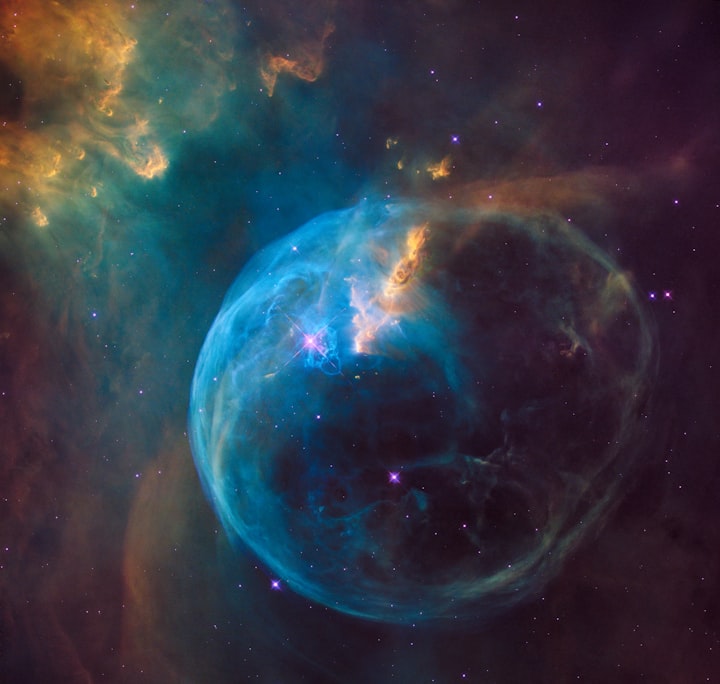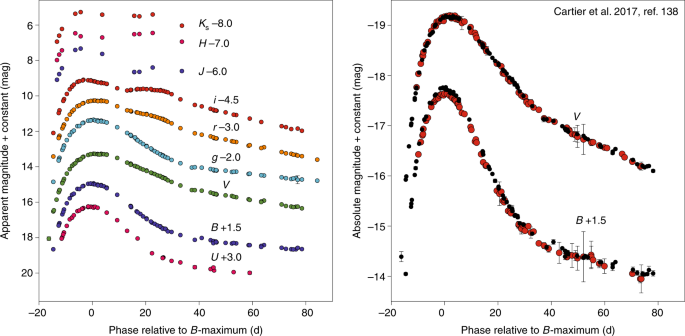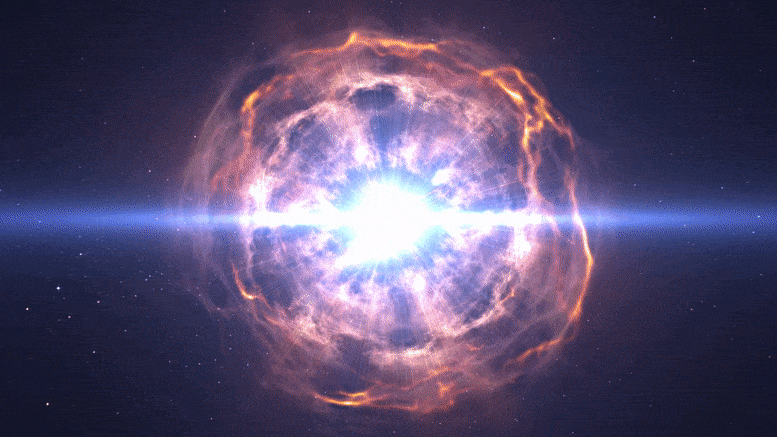A nova is a sudden brightening of a star, while a supernova is a massive explosion. Novas are less intense than supernovas, which release enormous amounts of energy and can outshine entire galaxies.
When studying celestial events, the distinction between novas and supernovas is crucial. Novas occur in binary star systems, where one star pulls material from its companion. On the other hand, supernovas mark the violent end of massive stars, leading to the creation of new elements and the dispersal of stellar material.
Understanding the differences between novas and supernovas sheds light on the diverse processes that shape the cosmos and impact the evolution of galaxies.
Explaining Nova
When it comes to understanding the differences between Nova and Supernova, it is essential to first grasp the concept of Nova. Explaining Nova involves exploring its definition, causes, and characteristics.
Definition
Nova: A nova is a sudden, temporary brightening of a star caused by a thermonuclear explosion on the surface of a white dwarf star.
Causes
- Accumulation of hydrogen gas on the surface of a white dwarf star
- When the hydrogen gas reaches a critical temperature and pressure, nuclear fusion reactions start
- This results in a sudden release of energy and a burst of brightness
Characteristics
- Increase in brightness over a short period, sometimes visible to the naked eye
- Temporary phenomenon lasting for a few days to a few weeks
- Occurs in binary star systems where one star is a white dwarf

Credit: vocal.media
Understanding Supernova
Definition
A supernova is a powerful and explosive event that occurs at the end of a star’s lifecycle.
Types
- There are two main types of supernovae: Type I and Type II.
- Type I is further divided into Type Ia and Type Ib/c.
Stages
- Supernova begins with the collapse of a massive star’s core.
- Next, a shock wave expands outward from the core, causing the star to explode.
Comparing Nova And Supernova
When it comes to celestial events, novas and supernovas frequently capture our attention. These astronomical phenomena are powerful displays of cosmic energy, but what sets them apart? In this article, we will compare novas and supernovas, examining their differences in cause, brightness, and energy release.
Differences In Cause
Novas occur in a binary star system, where two stars orbit one another. In this system, a white dwarf star gravitationally attracts matter from its companion star. Over time, the white dwarf accumulates enough matter to ignite a nuclear fusion reaction, resulting in a sudden increase in brightness. This explosion is known as a nova.
On the other hand, the cause of a supernova is drastically different. A supernova occurs when a massive star runs out of nuclear fuel. As a result, the core collapses under its own gravity, causing a catastrophic explosion. This explosion releases an immense amount of energy and creates a brilliant display of light.
Differences In Brightness
While both novas and supernovas are incredibly bright phenomena, their levels of luminosity differ significantly.
A nova involves a sudden increase in brightness by thousands to hundreds of thousands of times the original luminosity of the star. This surge in brightness can last for several days or even weeks before slowly fading back to its original brightness.
On the other hand, a supernova is an astronomical event that shines billions of times brighter than the star’s original brightness. These explosions can outshine entire galaxies and remain visible for weeks or even months before gradually fading away.
Differences In Energy Release
The energy release during a nova and a supernova is another key distinction between these celestial occurrences.
A nova releases a significant amount of energy, equivalent to around 1036 to 1037 joules, which is comparable to the total energy consumption of our sun over millions of years. While this is an impressive amount of energy, it pales in comparison to the energy unleashed during a supernova.
A supernova is an extraordinary event that releases an astounding amount of energy, typically on the order of 1044 to 1046 joules. To put that into perspective, this is more energy than the sun is projected to emit over its entire 10-billion-year lifespan.
In conclusion, novas and supernovas are both captivating astronomical events, but they differ significantly in their cause, brightness, and energy release. Novas result from a white dwarf star accumulating matter from its companion star, while supernovas occur when a massive star reaches the end of its life. While novas experience a temporary increase in brightness, supernovas can outshine entire galaxies. Lastly, while novas release an impressive amount of energy, supernovas unleash an extraordinary amount that surpasses the total energy output of the sun. Understanding these differences allows us to marvel at the incredible forces at play in our vast universe.

Credit: en.m.wikipedia.org
Observing Nova And Supernova
When it comes to observing celestial events in the vast expanse of our universe, there are few phenomena as captivating as the occurrences of nova and supernova. These explosive events, which involve the sudden increase in brightness of a star, present a captivating opportunity for astronomers and stargazers to witness the incredible forces at play in our cosmos. In this section, we will delve into the methods and tools used for observing nova and supernova, shedding light on the intricate processes involved in capturing these awe-inspiring events.
Types Of Telescopes
In the exploration of nova and supernova, astronomers rely heavily on the use of telescopes to observe and study these phenomena. There are various types of telescopes that are utilized for this purpose, each offering unique advantages for capturing celestial events. The most common types of telescopes used for observing nova and supernova include:
- Reflecting telescopes
- Refracting telescopes
- Radio telescopes
- X-ray telescopes
Astronomical Observatories
Astronomical observatories play a pivotal role in the observation of nova and supernova, providing state-of-the-art facilities for astronomers to study these extraordinary events. These observatories are equipped with advanced telescopes and instruments, allowing for precise measurements and observations of celestial phenomena. Some of the world’s leading astronomical observatories include:
- Mauna Kea Observatories in Hawaii
- European Southern Observatory (ESO) in Chile
- Keck Observatory in Hawaii
- Palomar Observatory in California
Impact Of Nova And Supernova
When it comes to the impact of celestial events, novas and supernovas are some of the most dramatic and powerful occurrences in the universe. These events have significant implications for stellar evolution and the distribution of elements in the cosmos, shaping the very fabric of the universe as we know it.
On Stellar Evolution
Nova and supernova events play crucial roles in the process of stellar evolution. During a nova, a white dwarf star undergoes a sudden increase in brightness due to the ignition of hydrogen on its surface, leading to a temporary burst of energy. This process does not result in the destruction of the star, but rather in the expulsion of outer layers of material into space.
On the other hand, a supernova marks the explosive end of a massive star’s life. This cataclysmic event results in the release of an immense amount of energy, leading to the creation of heavy elements and the dispersal of these materials into the cosmos. Supernovas are responsible for enriching the universe with elements crucial for the formation of planets, stars, and even life itself.
On Elements In The Universe
The aftermath of nova and supernova events contributes to the cosmic abundance of elements. While novas produce lighter elements such as carbon and oxygen, supernovas are crucial for the production of heavy elements like gold, silver, and uranium. These elements are then scattered across space, becoming the building blocks for future stars, planets, and ultimately, life.

Credit: www.nature.com
Historical Discoveries
Welcome to our fascinating exploration of the historical discoveries surrounding Nova and Supernova. In this article, we will delve into early observations and the significance of these extraordinary celestial events. Let’s embark on a journey through time and uncover the mysteries of the universe.
Early Observations
Centuries ago, astronomers made awe-inspiring observations that laid the foundation for our understanding of Nova and Supernova phenomena. These early stargazers noticed sudden eruptions of light in the night sky, and marveled at the appearance of new stars that seemingly emerged from nothingness.
Scholars like Tycho Brahe and Johannes Kepler in the 16th and 17th centuries were among the first to meticulously document these celestial events. Through their meticulous calculations and observations, they revealed crucial insights into the behavior of Novae and Supernovae.
Significance Of Discoveries
The discoveries made regarding Nova and Supernova have revolutionized our understanding of the cosmos and continue to shape our knowledge today. These spectacular events have provided astronomers with valuable data about the lifecycle of stars and the processes that occur in the vast expanse of space.
By studying Novae, researchers have been able to determine the recurrent outbursts of certain types of binary star systems. This knowledge has been instrumental in increasing our understanding of the evolutionary stages of stars and their eventual fate.
Supernovae, on the other hand, have proven to be fundamental in unlocking the mysteries of the universe. These cosmic explosions release an immense amount of energy and have provided astronomers with insights into the creation of heavy elements and the dispersal of enriched material throughout the cosmos.
Moreover, observing Supernovae has allowed scientists to investigate the expansion of the universe and the elusive dark matter, two enigmatic phenomena that have captivated the scientific community for decades.
From ancient astronomers to modern-day scientists, the historical discoveries surrounding Nova and Supernova have propelled our understanding of the cosmos to new heights. Through their observations and insights, we have gained invaluable knowledge that continues to inspire and shape our understanding of the vast universe we inhabit.
Current Research And Future Studies
Nova and supernova events are pivotal areas of study in the field of astronomy. Researchers are constantly pushing the boundaries of knowledge to understand these cosmic phenomena in greater detail.
Advancements In Technology
New technologies such as advanced telescopes and computational models have revolutionized our ability to study novae and supernovae. High-resolution imaging and real-time data processing are opening up new avenues of exploration.
Questions And Mysteries
Despite significant progress, many questions and mysteries surrounding novae and supernovae remain. Scientists are eager to unravel the complexities of these celestial events to gain deeper insights into the nature of the universe.
Some key areas of exploration include the origins of novae and supernovae, their impact on surrounding environments, and the formation of new elements. These mysteries drive ongoing research efforts around the globe.
Frequently Asked Questions Of Nova Vs Supernova
What Is The Difference Between A Nova And A Supernova?
A Nova is a sudden, short-lived brightening of a star, while a Supernova is a much more violent and explosive event resulting in the massive release of energy, often outshining an entire galaxy for a limited time. Both are stellar phenomena, but with vastly different levels of energy release.
Can A Nova Turn Into A Supernova?
No, a Nova cannot turn into a Supernova. Novae occur in binary star systems, where a white dwarf pulls material from its companion star. Supernovae, on the other hand, occur when a massive star runs out of fuel and undergoes a catastrophic collapse, leading to a violent explosion.
What Causes A Nova Event?
A Nova occurs when a white dwarf star accretes material from a companion star, triggering a nuclear fusion reaction on its surface. This results in a sudden increase in brightness and the ejection of material into space. The white dwarf remains intact after a Nova event.
Conclusion
To conclude, both Nova and Supernova are intriguing astronomical phenomena that captivate our curiosity. The stark differences lie in their magnitudes, with Nova being a relatively smaller explosion compared to the colossal destruction of a Supernova. By exploring and understanding these cosmic events, we gain valuable insights into the complexities of our universe, reminding us of our place in the grand scheme of things.
So, let’s continue marveling at these celestial shows and look forward to unraveling more mysteries beyond our Earthly realm.



